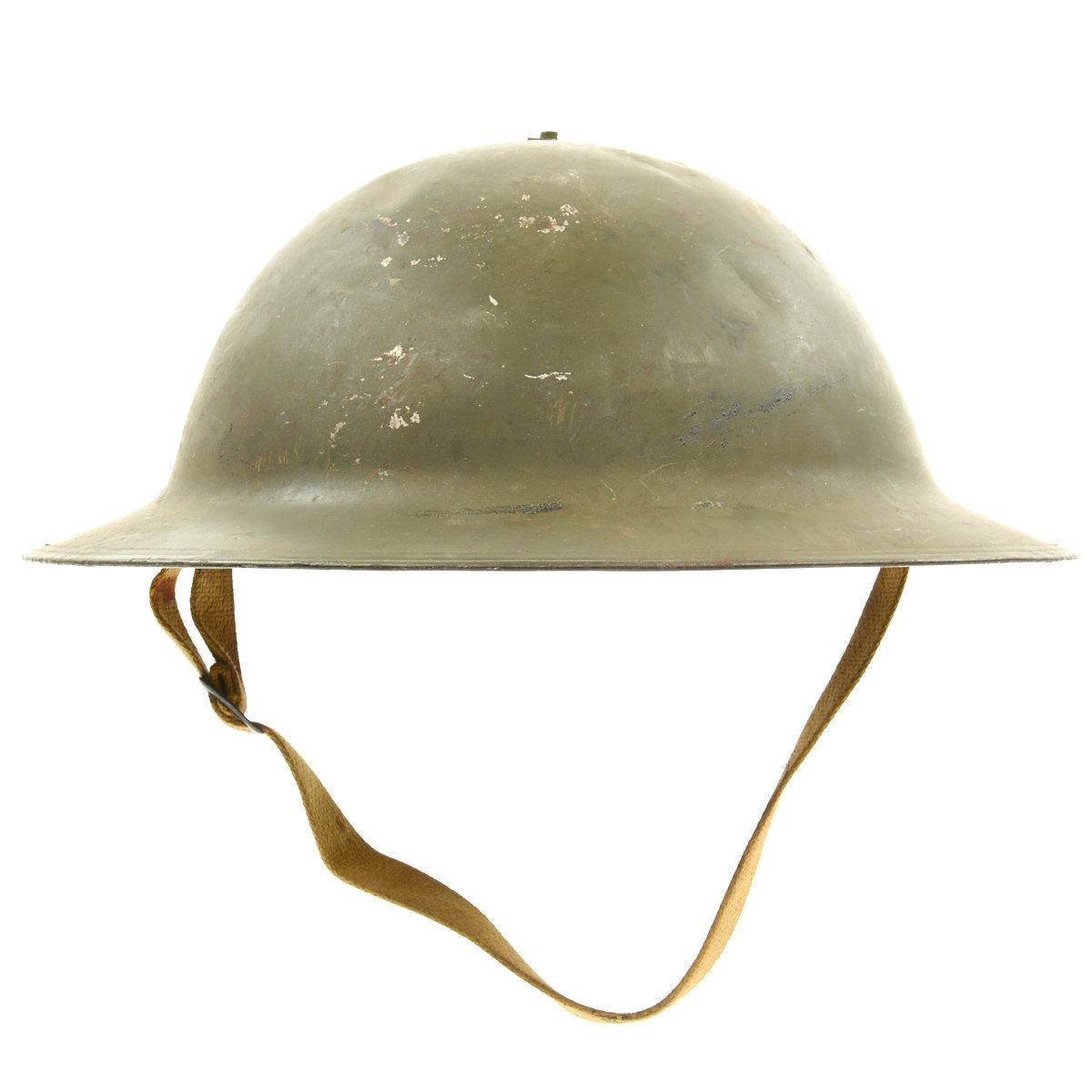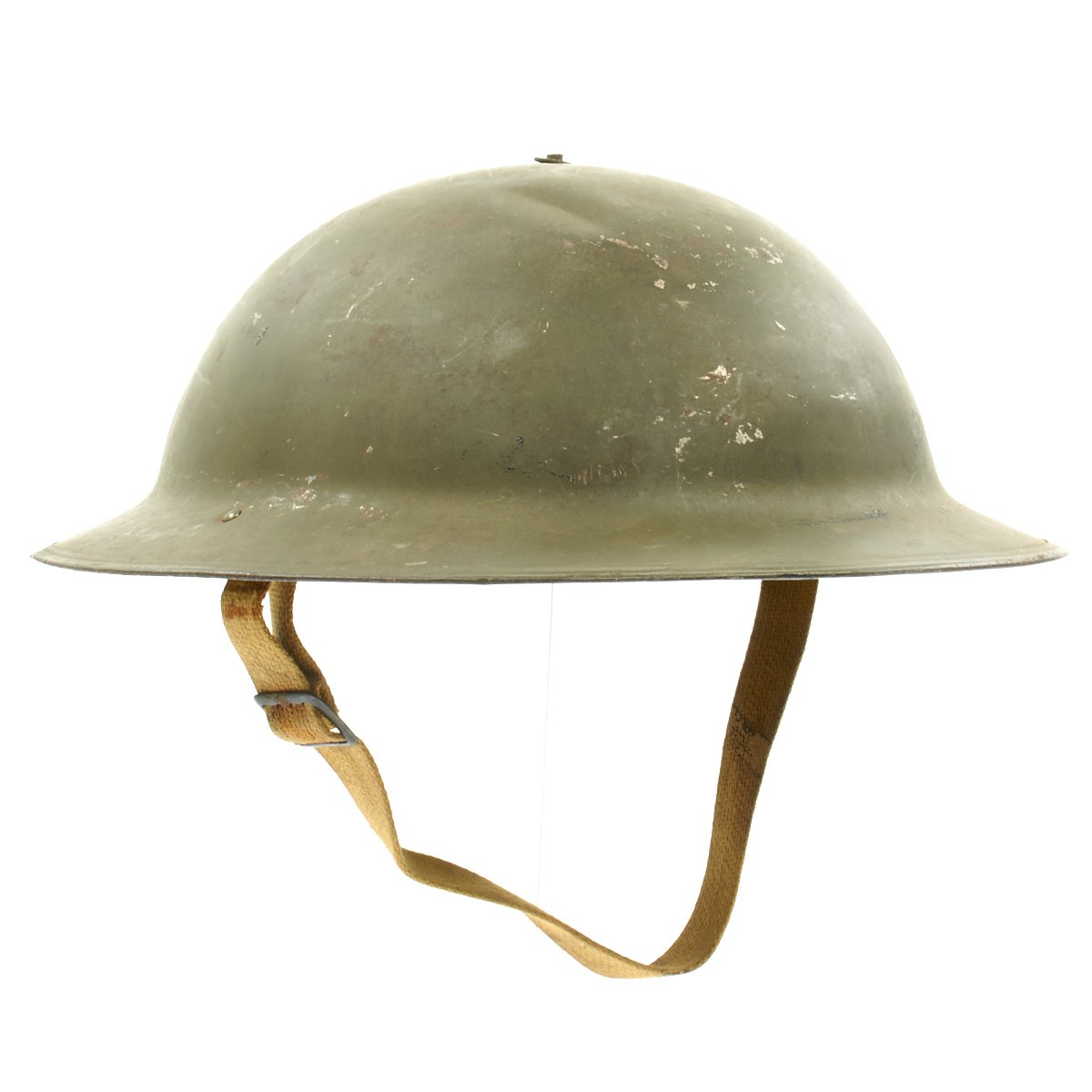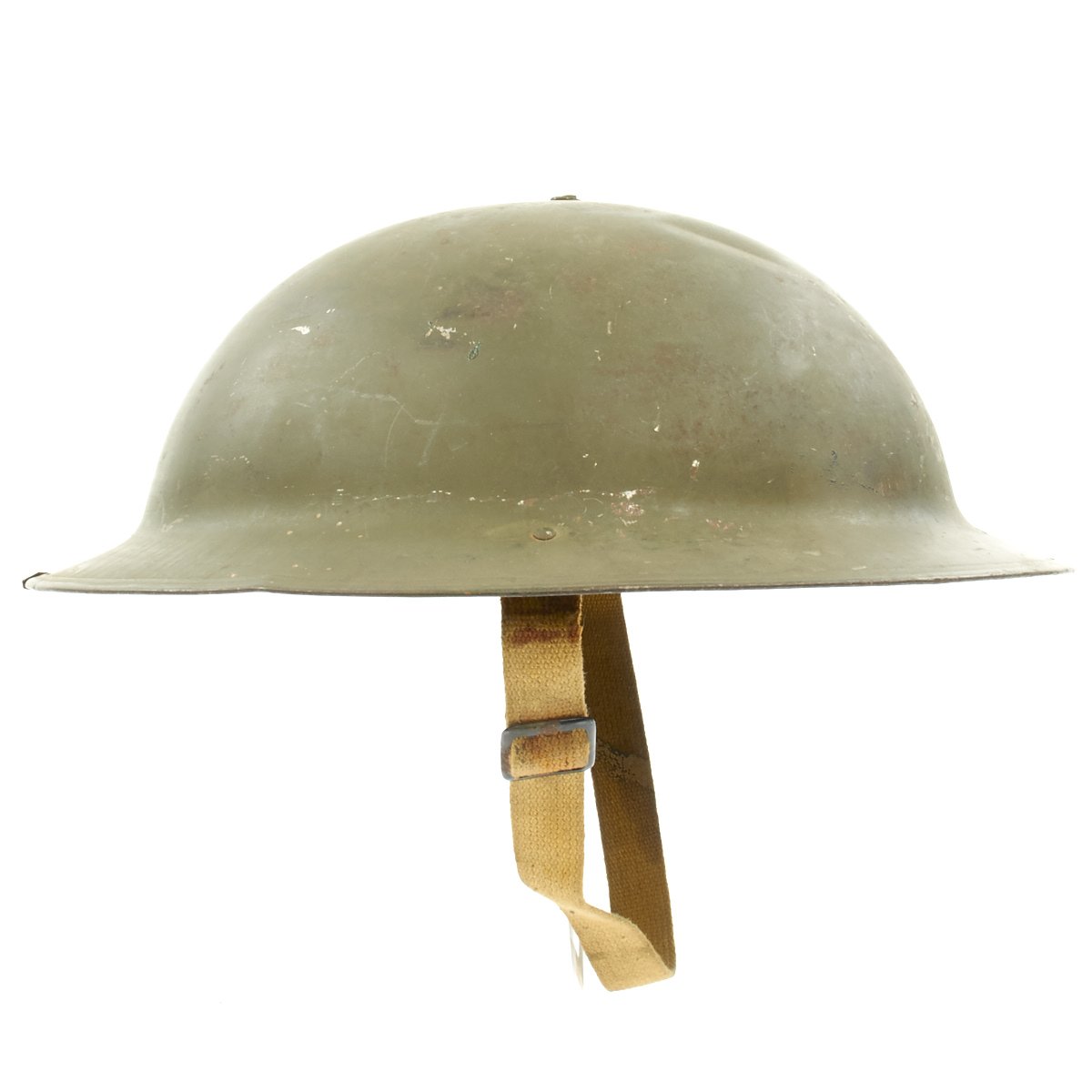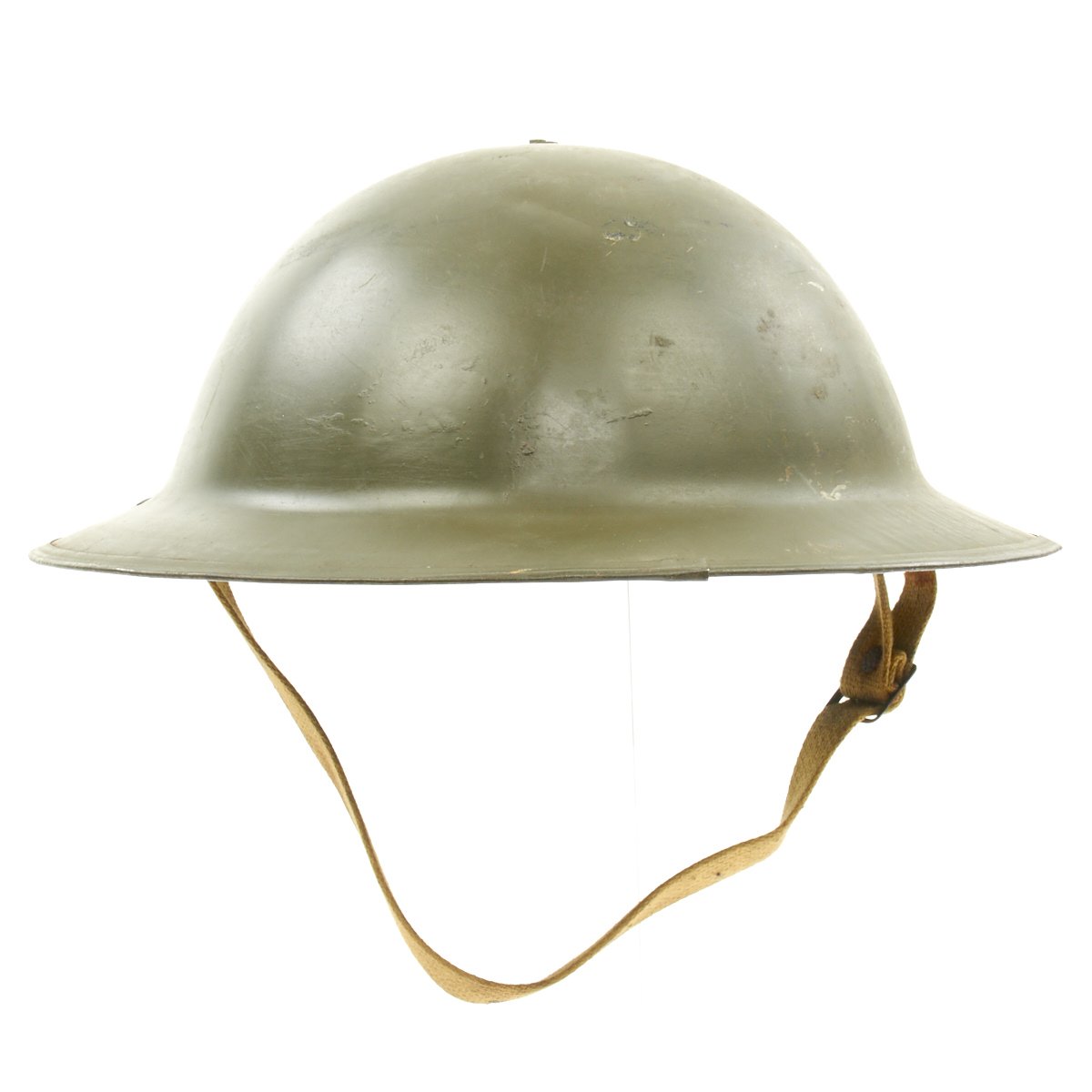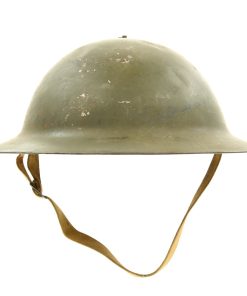Original British WWI MkI Type A First Model Brodie Steel Helmet Original Items
$ 295,00 $ 118,00
Original Item: Only One Available. This is an excellent example of an Original Early Production MkI Type A First Model Brodie Helmet. Unlike later models, this helmet is not made from non-magnetic “Hadfield’ Manganese steel, and does not have a stainless steel rim. Both appear to be regular hardened steel, and react to a magnet. It has the rippling on the rim typical of an early production model.
The helmet is not marked on the shell, which is also typical of early production stages, and it has the typical split pin attachments for the rounded chin strap bales bases. The oilcloth liner is in good shape, and is held in place by web straps, not the usual leather seen in these helmets, so this is most likely a later replacement. The liner is held in place by a rivet installed directly through the liner and chin strap.
The paint is 100% original as far as we can tell. This is an excellent condition, complete and original early WWI steel Tommy helmet.
The Brodie helmet, called Helmet, steel, Mark I helmet in Britain and the M1917 Helmet in the U.S., is a steel combat helmet designed and patented in 1915 by Englishman John Leopold Brodie. Colloquially, it was called the shrapnel helmet, Tommy helmet, Tin Hat, and in the United States the doughboy helmet. Worn by Australians during WW2 and sometimes known as ‘Panic Hat’. It was also known as the dishpan hat, tin pan hat, washbasin, battle bowler (when worn by officers), and Kelly helmet. The US version, the M1917, was copied from the British Mk 1 steel helmet of 1916. The German Army called it the Salatschüssel (salad bowl).
At about the same time, the British War Office had seen a similar need for steel helmets. The War Office Invention Department was ordered to evaluate the French design. They decided that it was not strong enough and too complex to be swiftly manufactured. British industry was not geared up to an all-out effort of war production in the early days of World War I, which also led to the shell shortage of 1915.
A design patented in 1915 by John L. Brodie of London offered advantages over the French design. It was constructed in one piece that could be pressed from a single thick sheet of steel, giving it added strength.
Brodie’s design resembled the medieval infantry kettle hat or chapel-de-fer, unlike the German Stahlhelm, which resembled the medieval sallet. The Brodie had a shallow circular crown with a wide brim around the edge, a leather liner and a leather chinstrap. The helmet’s “soup bowl” shape was designed to protect the wearer’s head and shoulders from Shrapnel shell projectiles bursting from above the trenches. The design allowed the use of relatively thick steel that could be formed in a single pressing while maintaining the helmet’s thickness. This made it more resistant to projectiles but it offered less protection to the lower head and neck than other helmets.
The original design (Type A) was made of mild steel with a brim 1.5-2 inches (3851 mm) wide. The Type A was in production for just a few weeks before the specification was changed and the Type B was introduced in October 1915. The specification was altered at the suggestion of Sir Robert Hadfield to a harder steel with 12% manganese content, which became known as “Hadfield’s steel”, which was virtually impervious to shrapnel balls hitting from above. Ballistically this increased protection for the wearer by 10 percent. It could withstand a .45 caliber pistol bullet traveling at 600 feet (180 m) per second fired at a distance of 10 feet (3.0 m). It also had a narrower brim and a more domed crown.
The original paint scheme, suggested by Brodie, was a mottled light green, blue, and orange camouflage but they were also painted in green or blue-grey. That same month the first delivery of the helmets was made to British Army troops. Initially, there were far from enough helmets to equip every man, so they were designated as “trench stores”, to be kept in the front line and used by each unit that occupied the sector. It was not until the summer of 1916, when the first one million helmets had been produced, that they could be generally issued.
The Brodie helmet reduced casualties but was criticized by General Herbert Plumer on the grounds that it was too shallow and too light-reflective, its rim was too sharp, and its lining was too slippery. These criticisms were addressed in the Mark I model helmet of 1916, which had a separate folded rim, a two-part liner and matte khaki paint finished with sand, sawdust, or crushed cork to give a dull, non-reflective appearance. In 1917, the liner was modified to include a rubber cushion to make it more comfortable, although this was not adopted for the M1917. Towards the end of the war, helmets were often painted with unit insignia. These are often called “parade helmets” by collectors.
Fast Shipping with Professional Packaging
Thanks to our longstanding association with UPS FedEx DHL, and other major international carriers, we are able to provide a range of shipping options. Our warehouse staff is expertly trained and will wrap your products according to our exact and precise specifications. Prior to shipping, your goods will be thoroughly examined and securely secured. We ship to thousands clients each day across multiple countries. This shows how we're dedicated to be the largest retailer on the internet. Warehouses and distribution centres can be located throughout Europe as well as the USA.
Note: Orders with more than one item will be assigned a processing date depending on the item.
Before shipping before shipping, we'll conduct a thorough inspection of the items you have ordered. Today, the majority of orders will be delivered within 48 hours. The delivery time will be between 3-7 days.
Returns
The stock is dynamic and we cannot completely manage it because multiple stakeholders are involved, including our factory and warehouse. So the actual stock may alter at any time. It's possible that you may not receive your order once the order has been made.
Our policy is valid for a period of 30 days. If you don't receive the product within 30 days, we are not able to issue a refund or an exchange.
You can only return an item if it is unused and in the same state as the day you received it. You must have the item in its original packaging.
Related products
Uncategorized
Uncategorized
Uncategorized
Australian WWII Owen MK1 Machine Carbine SMG Custom Fabricated Replica with Sling Original Items
Uncategorized
Uncategorized
Uncategorized
Uncategorized
Uncategorized
Uncategorized
Uncategorized
Band of Brothers ORIGINAL GERMAN WWII Le. F.H. 18 10.5cm ARTILLERY PIECE Original Items
Uncategorized
Uncategorized
Armoured Fighting Vehicles of the World: AFVs of World War One (Hardcover Book) New Made Items
Uncategorized
Armored Burgonet Helmet & Polearm from Scottish Castle Leith Hall Circa 1700 Original Items
Uncategorized
Uncategorized
Uncategorized
